University Case Study: Mixed Fortunes at Domino's Business Analysis
VerifiedAdded on 2020/03/04
|8
|1939
|121
Case Study
AI Summary
This case study examines the 'Mixed Fortunes at Domino's,' based on investigative reports, highlighting problems within the franchise model. Key issues include franchisee struggles due to high royalties, declining pizza prices, and increasing operational costs, leading to profitability concerns. Employee dissatisfaction is also addressed, caused by underpayment, long working hours, and lack of support. The study identifies the need for improved communication, fair remuneration, and employee engagement. Proposed solutions include expertise in franchise business, prioritizing stakeholder loyalty, building a strong brand, and consulting with franchisees. Recommendations focus on enhancing employee and customer retention through training, market analysis, and relationship management to foster a successful franchise business. The case study emphasizes the importance of addressing these issues for Domino's continued success and growth.
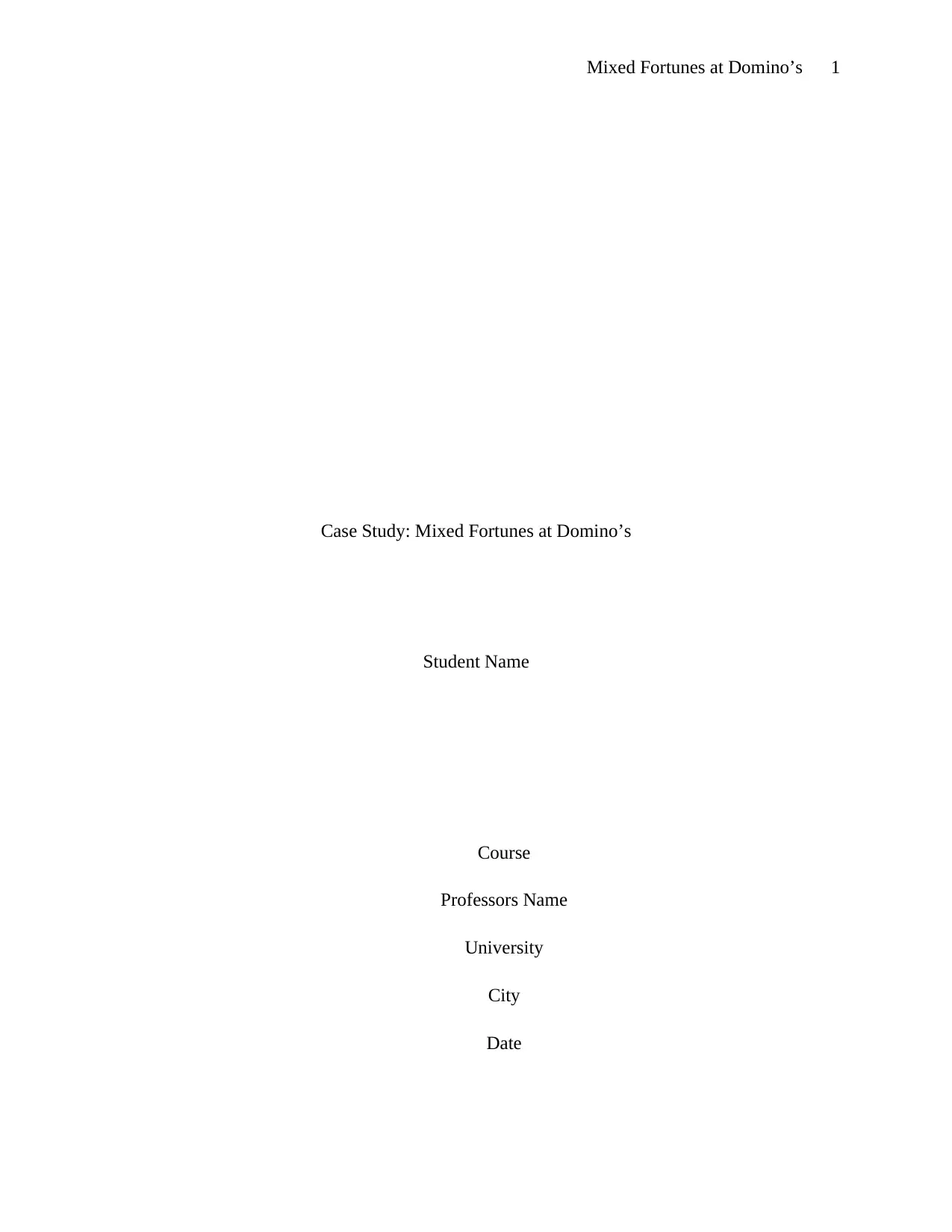
Mixed Fortunes at Domino’s 1
Case Study: Mixed Fortunes at Domino’s
Student Name
Course
Professors Name
University
City
Date
Case Study: Mixed Fortunes at Domino’s
Student Name
Course
Professors Name
University
City
Date
Paraphrase This Document
Need a fresh take? Get an instant paraphrase of this document with our AI Paraphraser
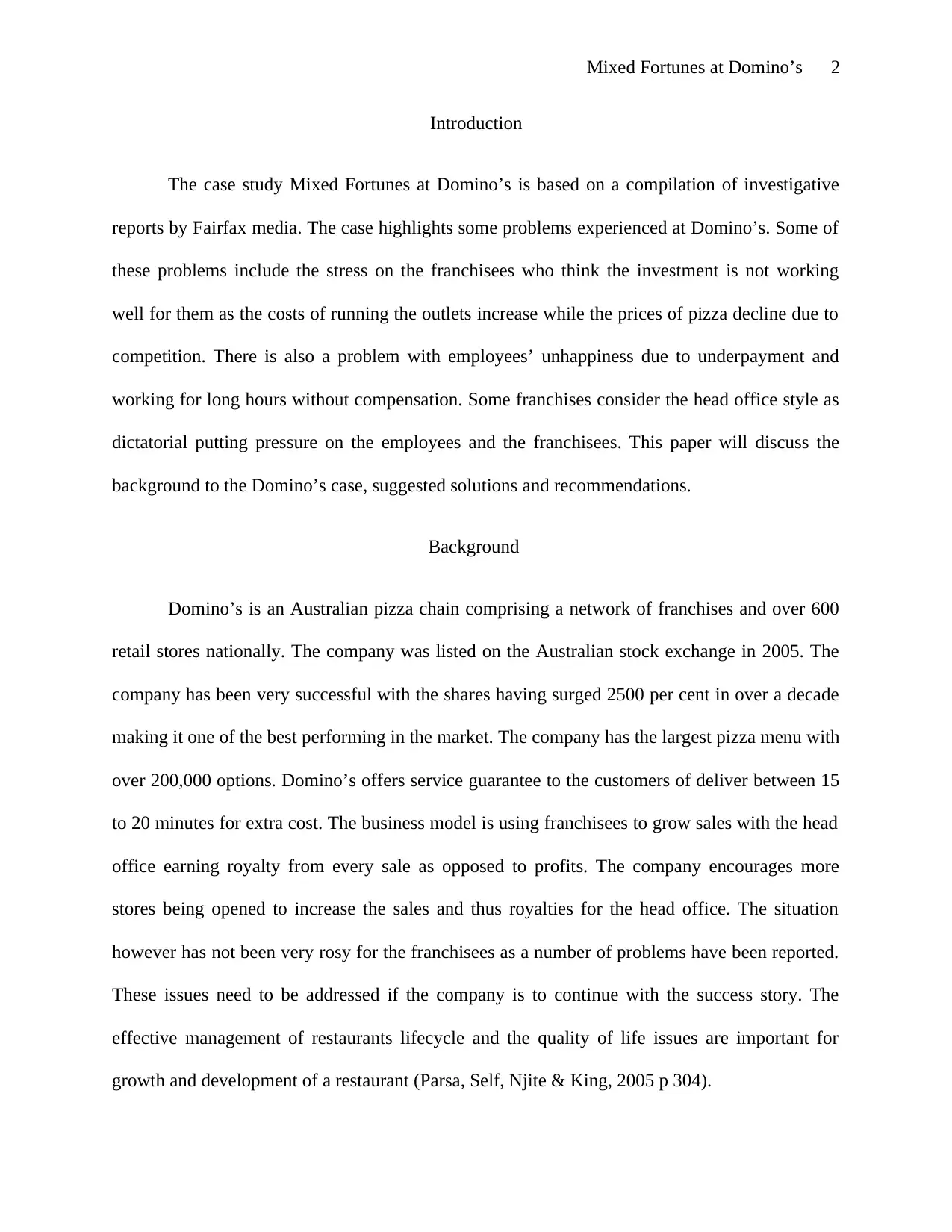
Mixed Fortunes at Domino’s 2
Introduction
The case study Mixed Fortunes at Domino’s is based on a compilation of investigative
reports by Fairfax media. The case highlights some problems experienced at Domino’s. Some of
these problems include the stress on the franchisees who think the investment is not working
well for them as the costs of running the outlets increase while the prices of pizza decline due to
competition. There is also a problem with employees’ unhappiness due to underpayment and
working for long hours without compensation. Some franchises consider the head office style as
dictatorial putting pressure on the employees and the franchisees. This paper will discuss the
background to the Domino’s case, suggested solutions and recommendations.
Background
Domino’s is an Australian pizza chain comprising a network of franchises and over 600
retail stores nationally. The company was listed on the Australian stock exchange in 2005. The
company has been very successful with the shares having surged 2500 per cent in over a decade
making it one of the best performing in the market. The company has the largest pizza menu with
over 200,000 options. Domino’s offers service guarantee to the customers of deliver between 15
to 20 minutes for extra cost. The business model is using franchisees to grow sales with the head
office earning royalty from every sale as opposed to profits. The company encourages more
stores being opened to increase the sales and thus royalties for the head office. The situation
however has not been very rosy for the franchisees as a number of problems have been reported.
These issues need to be addressed if the company is to continue with the success story. The
effective management of restaurants lifecycle and the quality of life issues are important for
growth and development of a restaurant (Parsa, Self, Njite & King, 2005 p 304).
Introduction
The case study Mixed Fortunes at Domino’s is based on a compilation of investigative
reports by Fairfax media. The case highlights some problems experienced at Domino’s. Some of
these problems include the stress on the franchisees who think the investment is not working
well for them as the costs of running the outlets increase while the prices of pizza decline due to
competition. There is also a problem with employees’ unhappiness due to underpayment and
working for long hours without compensation. Some franchises consider the head office style as
dictatorial putting pressure on the employees and the franchisees. This paper will discuss the
background to the Domino’s case, suggested solutions and recommendations.
Background
Domino’s is an Australian pizza chain comprising a network of franchises and over 600
retail stores nationally. The company was listed on the Australian stock exchange in 2005. The
company has been very successful with the shares having surged 2500 per cent in over a decade
making it one of the best performing in the market. The company has the largest pizza menu with
over 200,000 options. Domino’s offers service guarantee to the customers of deliver between 15
to 20 minutes for extra cost. The business model is using franchisees to grow sales with the head
office earning royalty from every sale as opposed to profits. The company encourages more
stores being opened to increase the sales and thus royalties for the head office. The situation
however has not been very rosy for the franchisees as a number of problems have been reported.
These issues need to be addressed if the company is to continue with the success story. The
effective management of restaurants lifecycle and the quality of life issues are important for
growth and development of a restaurant (Parsa, Self, Njite & King, 2005 p 304).
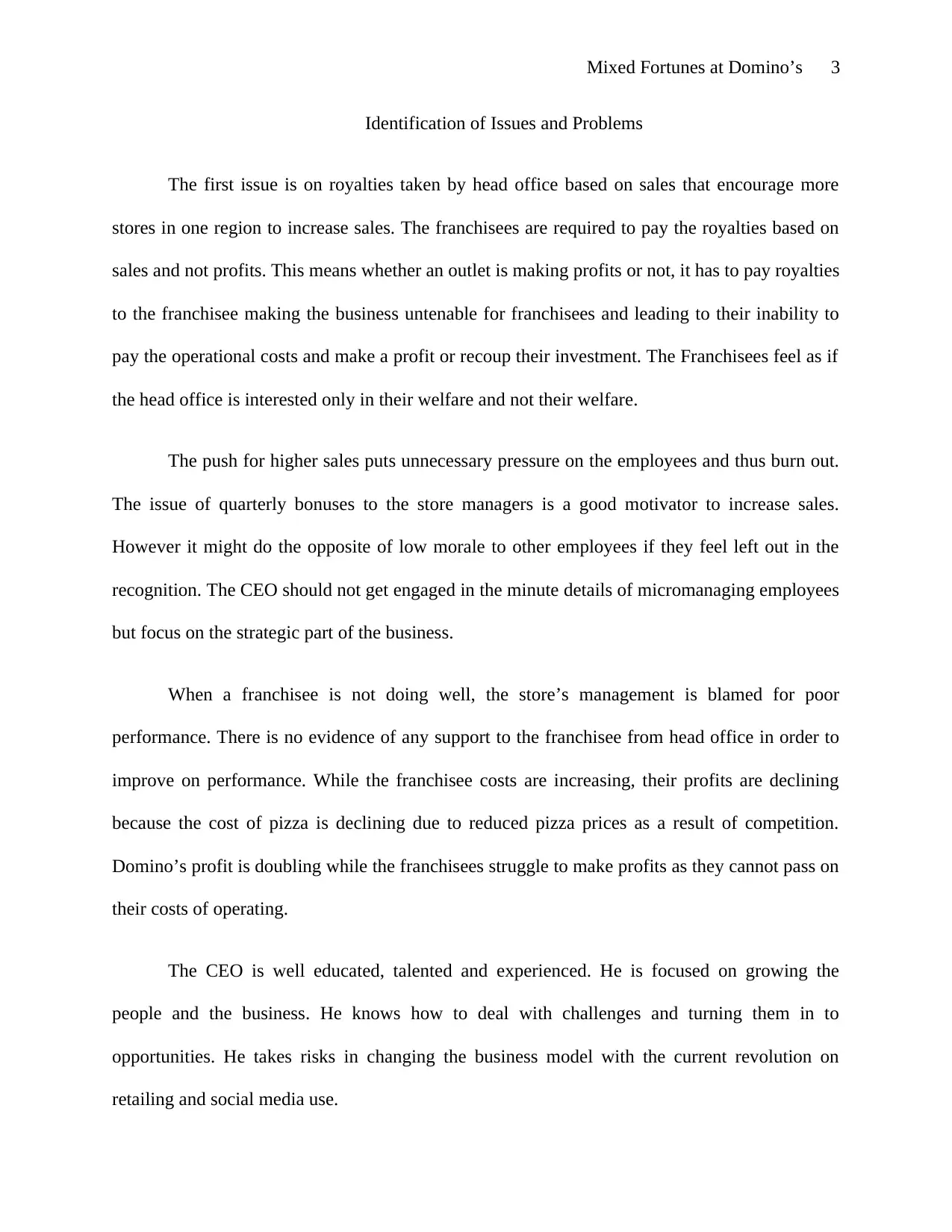
Mixed Fortunes at Domino’s 3
Identification of Issues and Problems
The first issue is on royalties taken by head office based on sales that encourage more
stores in one region to increase sales. The franchisees are required to pay the royalties based on
sales and not profits. This means whether an outlet is making profits or not, it has to pay royalties
to the franchisee making the business untenable for franchisees and leading to their inability to
pay the operational costs and make a profit or recoup their investment. The Franchisees feel as if
the head office is interested only in their welfare and not their welfare.
The push for higher sales puts unnecessary pressure on the employees and thus burn out.
The issue of quarterly bonuses to the store managers is a good motivator to increase sales.
However it might do the opposite of low morale to other employees if they feel left out in the
recognition. The CEO should not get engaged in the minute details of micromanaging employees
but focus on the strategic part of the business.
When a franchisee is not doing well, the store’s management is blamed for poor
performance. There is no evidence of any support to the franchisee from head office in order to
improve on performance. While the franchisee costs are increasing, their profits are declining
because the cost of pizza is declining due to reduced pizza prices as a result of competition.
Domino’s profit is doubling while the franchisees struggle to make profits as they cannot pass on
their costs of operating.
The CEO is well educated, talented and experienced. He is focused on growing the
people and the business. He knows how to deal with challenges and turning them in to
opportunities. He takes risks in changing the business model with the current revolution on
retailing and social media use.
Identification of Issues and Problems
The first issue is on royalties taken by head office based on sales that encourage more
stores in one region to increase sales. The franchisees are required to pay the royalties based on
sales and not profits. This means whether an outlet is making profits or not, it has to pay royalties
to the franchisee making the business untenable for franchisees and leading to their inability to
pay the operational costs and make a profit or recoup their investment. The Franchisees feel as if
the head office is interested only in their welfare and not their welfare.
The push for higher sales puts unnecessary pressure on the employees and thus burn out.
The issue of quarterly bonuses to the store managers is a good motivator to increase sales.
However it might do the opposite of low morale to other employees if they feel left out in the
recognition. The CEO should not get engaged in the minute details of micromanaging employees
but focus on the strategic part of the business.
When a franchisee is not doing well, the store’s management is blamed for poor
performance. There is no evidence of any support to the franchisee from head office in order to
improve on performance. While the franchisee costs are increasing, their profits are declining
because the cost of pizza is declining due to reduced pizza prices as a result of competition.
Domino’s profit is doubling while the franchisees struggle to make profits as they cannot pass on
their costs of operating.
The CEO is well educated, talented and experienced. He is focused on growing the
people and the business. He knows how to deal with challenges and turning them in to
opportunities. He takes risks in changing the business model with the current revolution on
retailing and social media use.
⊘ This is a preview!⊘
Do you want full access?
Subscribe today to unlock all pages.

Trusted by 1+ million students worldwide
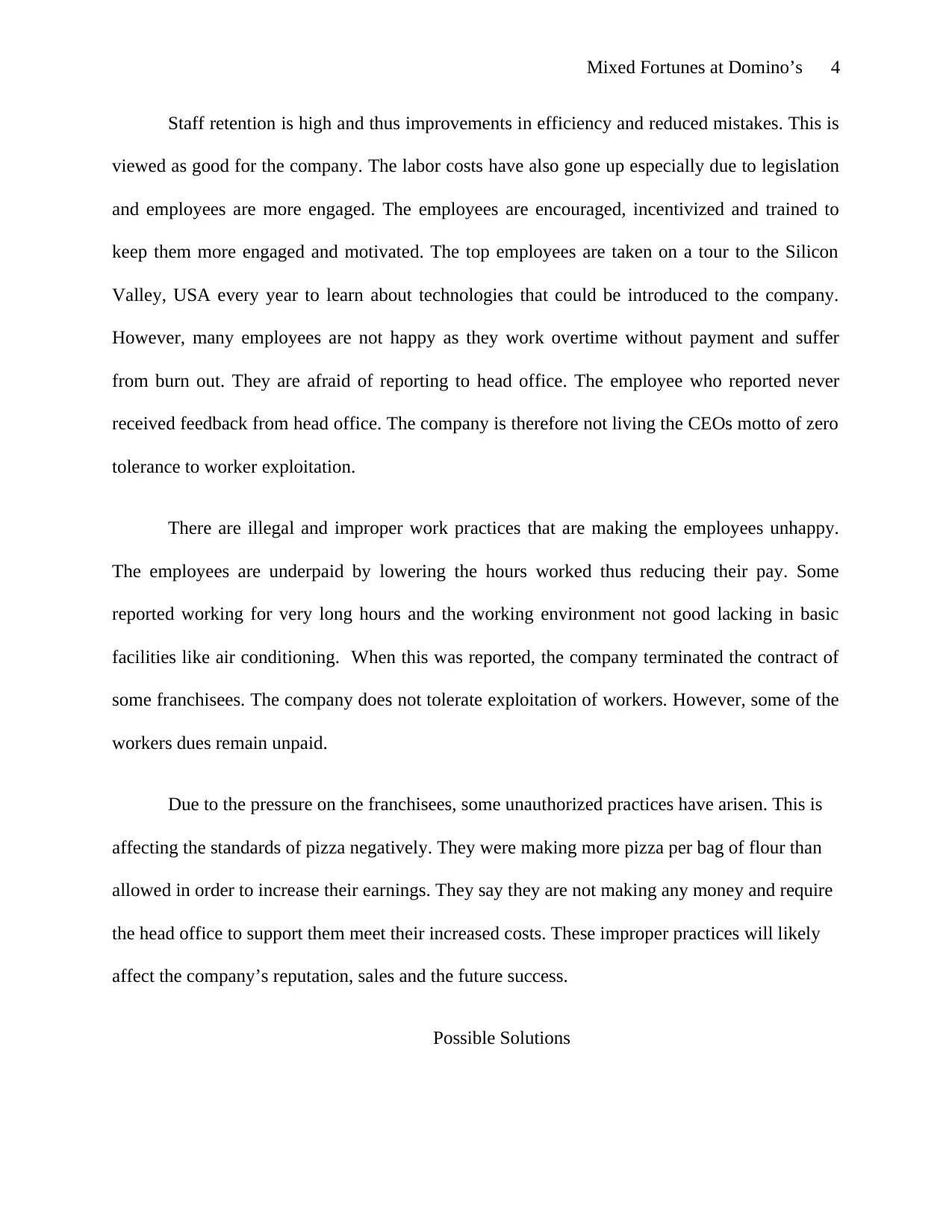
Mixed Fortunes at Domino’s 4
Staff retention is high and thus improvements in efficiency and reduced mistakes. This is
viewed as good for the company. The labor costs have also gone up especially due to legislation
and employees are more engaged. The employees are encouraged, incentivized and trained to
keep them more engaged and motivated. The top employees are taken on a tour to the Silicon
Valley, USA every year to learn about technologies that could be introduced to the company.
However, many employees are not happy as they work overtime without payment and suffer
from burn out. They are afraid of reporting to head office. The employee who reported never
received feedback from head office. The company is therefore not living the CEOs motto of zero
tolerance to worker exploitation.
There are illegal and improper work practices that are making the employees unhappy.
The employees are underpaid by lowering the hours worked thus reducing their pay. Some
reported working for very long hours and the working environment not good lacking in basic
facilities like air conditioning. When this was reported, the company terminated the contract of
some franchisees. The company does not tolerate exploitation of workers. However, some of the
workers dues remain unpaid.
Due to the pressure on the franchisees, some unauthorized practices have arisen. This is
affecting the standards of pizza negatively. They were making more pizza per bag of flour than
allowed in order to increase their earnings. They say they are not making any money and require
the head office to support them meet their increased costs. These improper practices will likely
affect the company’s reputation, sales and the future success.
Possible Solutions
Staff retention is high and thus improvements in efficiency and reduced mistakes. This is
viewed as good for the company. The labor costs have also gone up especially due to legislation
and employees are more engaged. The employees are encouraged, incentivized and trained to
keep them more engaged and motivated. The top employees are taken on a tour to the Silicon
Valley, USA every year to learn about technologies that could be introduced to the company.
However, many employees are not happy as they work overtime without payment and suffer
from burn out. They are afraid of reporting to head office. The employee who reported never
received feedback from head office. The company is therefore not living the CEOs motto of zero
tolerance to worker exploitation.
There are illegal and improper work practices that are making the employees unhappy.
The employees are underpaid by lowering the hours worked thus reducing their pay. Some
reported working for very long hours and the working environment not good lacking in basic
facilities like air conditioning. When this was reported, the company terminated the contract of
some franchisees. The company does not tolerate exploitation of workers. However, some of the
workers dues remain unpaid.
Due to the pressure on the franchisees, some unauthorized practices have arisen. This is
affecting the standards of pizza negatively. They were making more pizza per bag of flour than
allowed in order to increase their earnings. They say they are not making any money and require
the head office to support them meet their increased costs. These improper practices will likely
affect the company’s reputation, sales and the future success.
Possible Solutions
Paraphrase This Document
Need a fresh take? Get an instant paraphrase of this document with our AI Paraphraser
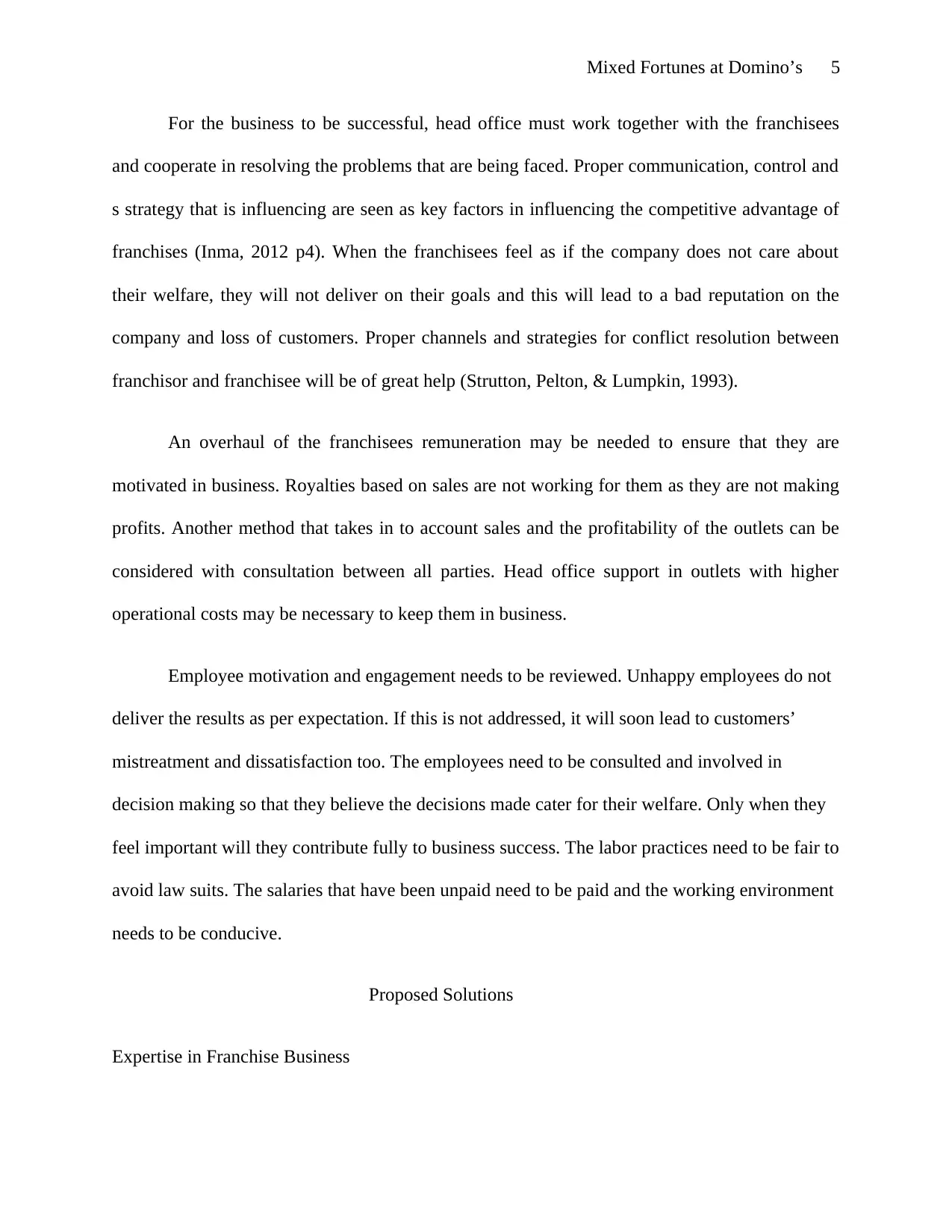
Mixed Fortunes at Domino’s 5
For the business to be successful, head office must work together with the franchisees
and cooperate in resolving the problems that are being faced. Proper communication, control and
s strategy that is influencing are seen as key factors in influencing the competitive advantage of
franchises (Inma, 2012 p4). When the franchisees feel as if the company does not care about
their welfare, they will not deliver on their goals and this will lead to a bad reputation on the
company and loss of customers. Proper channels and strategies for conflict resolution between
franchisor and franchisee will be of great help (Strutton, Pelton, & Lumpkin, 1993).
An overhaul of the franchisees remuneration may be needed to ensure that they are
motivated in business. Royalties based on sales are not working for them as they are not making
profits. Another method that takes in to account sales and the profitability of the outlets can be
considered with consultation between all parties. Head office support in outlets with higher
operational costs may be necessary to keep them in business.
Employee motivation and engagement needs to be reviewed. Unhappy employees do not
deliver the results as per expectation. If this is not addressed, it will soon lead to customers’
mistreatment and dissatisfaction too. The employees need to be consulted and involved in
decision making so that they believe the decisions made cater for their welfare. Only when they
feel important will they contribute fully to business success. The labor practices need to be fair to
avoid law suits. The salaries that have been unpaid need to be paid and the working environment
needs to be conducive.
Proposed Solutions
Expertise in Franchise Business
For the business to be successful, head office must work together with the franchisees
and cooperate in resolving the problems that are being faced. Proper communication, control and
s strategy that is influencing are seen as key factors in influencing the competitive advantage of
franchises (Inma, 2012 p4). When the franchisees feel as if the company does not care about
their welfare, they will not deliver on their goals and this will lead to a bad reputation on the
company and loss of customers. Proper channels and strategies for conflict resolution between
franchisor and franchisee will be of great help (Strutton, Pelton, & Lumpkin, 1993).
An overhaul of the franchisees remuneration may be needed to ensure that they are
motivated in business. Royalties based on sales are not working for them as they are not making
profits. Another method that takes in to account sales and the profitability of the outlets can be
considered with consultation between all parties. Head office support in outlets with higher
operational costs may be necessary to keep them in business.
Employee motivation and engagement needs to be reviewed. Unhappy employees do not
deliver the results as per expectation. If this is not addressed, it will soon lead to customers’
mistreatment and dissatisfaction too. The employees need to be consulted and involved in
decision making so that they believe the decisions made cater for their welfare. Only when they
feel important will they contribute fully to business success. The labor practices need to be fair to
avoid law suits. The salaries that have been unpaid need to be paid and the working environment
needs to be conducive.
Proposed Solutions
Expertise in Franchise Business
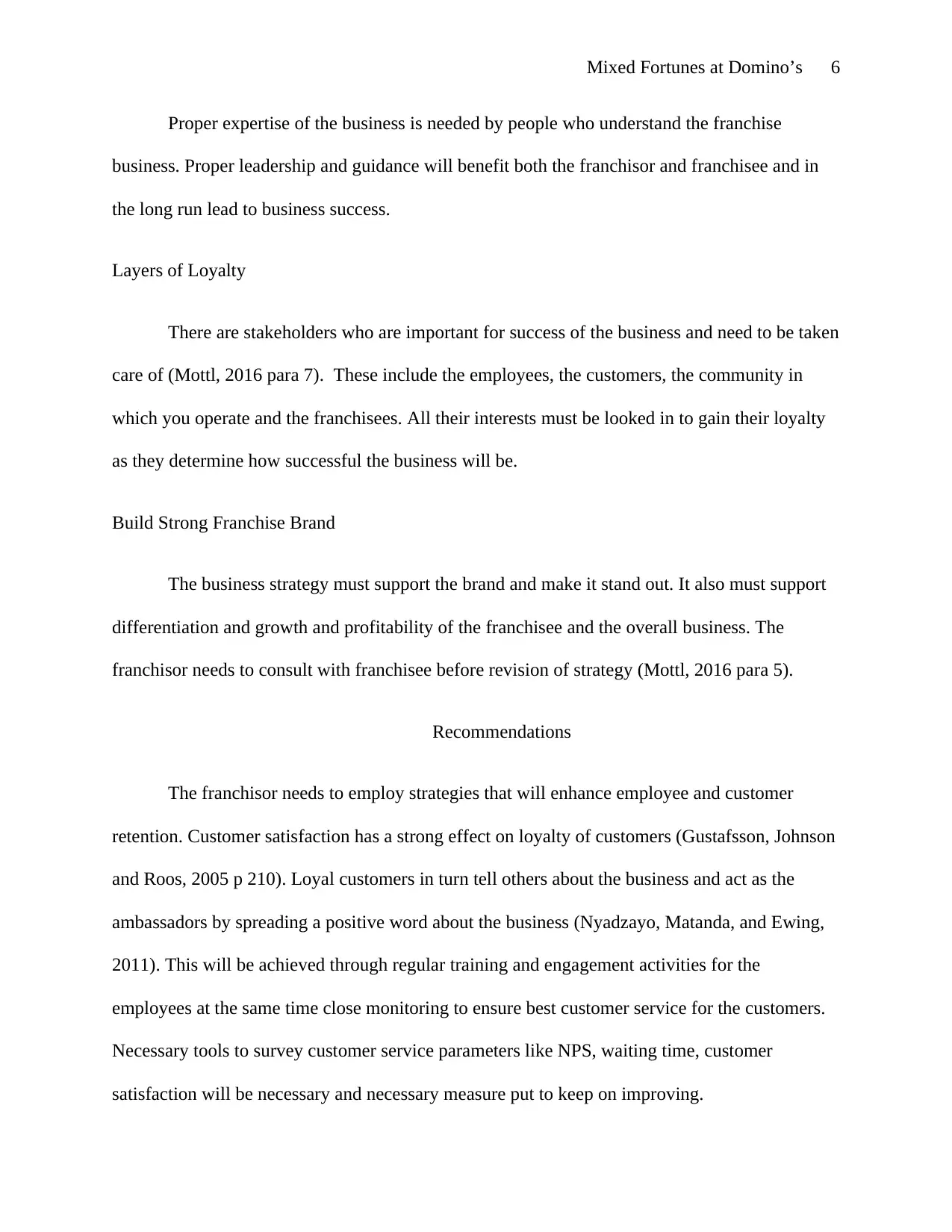
Mixed Fortunes at Domino’s 6
Proper expertise of the business is needed by people who understand the franchise
business. Proper leadership and guidance will benefit both the franchisor and franchisee and in
the long run lead to business success.
Layers of Loyalty
There are stakeholders who are important for success of the business and need to be taken
care of (Mottl, 2016 para 7). These include the employees, the customers, the community in
which you operate and the franchisees. All their interests must be looked in to gain their loyalty
as they determine how successful the business will be.
Build Strong Franchise Brand
The business strategy must support the brand and make it stand out. It also must support
differentiation and growth and profitability of the franchisee and the overall business. The
franchisor needs to consult with franchisee before revision of strategy (Mottl, 2016 para 5).
Recommendations
The franchisor needs to employ strategies that will enhance employee and customer
retention. Customer satisfaction has a strong effect on loyalty of customers (Gustafsson, Johnson
and Roos, 2005 p 210). Loyal customers in turn tell others about the business and act as the
ambassadors by spreading a positive word about the business (Nyadzayo, Matanda, and Ewing,
2011). This will be achieved through regular training and engagement activities for the
employees at the same time close monitoring to ensure best customer service for the customers.
Necessary tools to survey customer service parameters like NPS, waiting time, customer
satisfaction will be necessary and necessary measure put to keep on improving.
Proper expertise of the business is needed by people who understand the franchise
business. Proper leadership and guidance will benefit both the franchisor and franchisee and in
the long run lead to business success.
Layers of Loyalty
There are stakeholders who are important for success of the business and need to be taken
care of (Mottl, 2016 para 7). These include the employees, the customers, the community in
which you operate and the franchisees. All their interests must be looked in to gain their loyalty
as they determine how successful the business will be.
Build Strong Franchise Brand
The business strategy must support the brand and make it stand out. It also must support
differentiation and growth and profitability of the franchisee and the overall business. The
franchisor needs to consult with franchisee before revision of strategy (Mottl, 2016 para 5).
Recommendations
The franchisor needs to employ strategies that will enhance employee and customer
retention. Customer satisfaction has a strong effect on loyalty of customers (Gustafsson, Johnson
and Roos, 2005 p 210). Loyal customers in turn tell others about the business and act as the
ambassadors by spreading a positive word about the business (Nyadzayo, Matanda, and Ewing,
2011). This will be achieved through regular training and engagement activities for the
employees at the same time close monitoring to ensure best customer service for the customers.
Necessary tools to survey customer service parameters like NPS, waiting time, customer
satisfaction will be necessary and necessary measure put to keep on improving.
⊘ This is a preview!⊘
Do you want full access?
Subscribe today to unlock all pages.

Trusted by 1+ million students worldwide
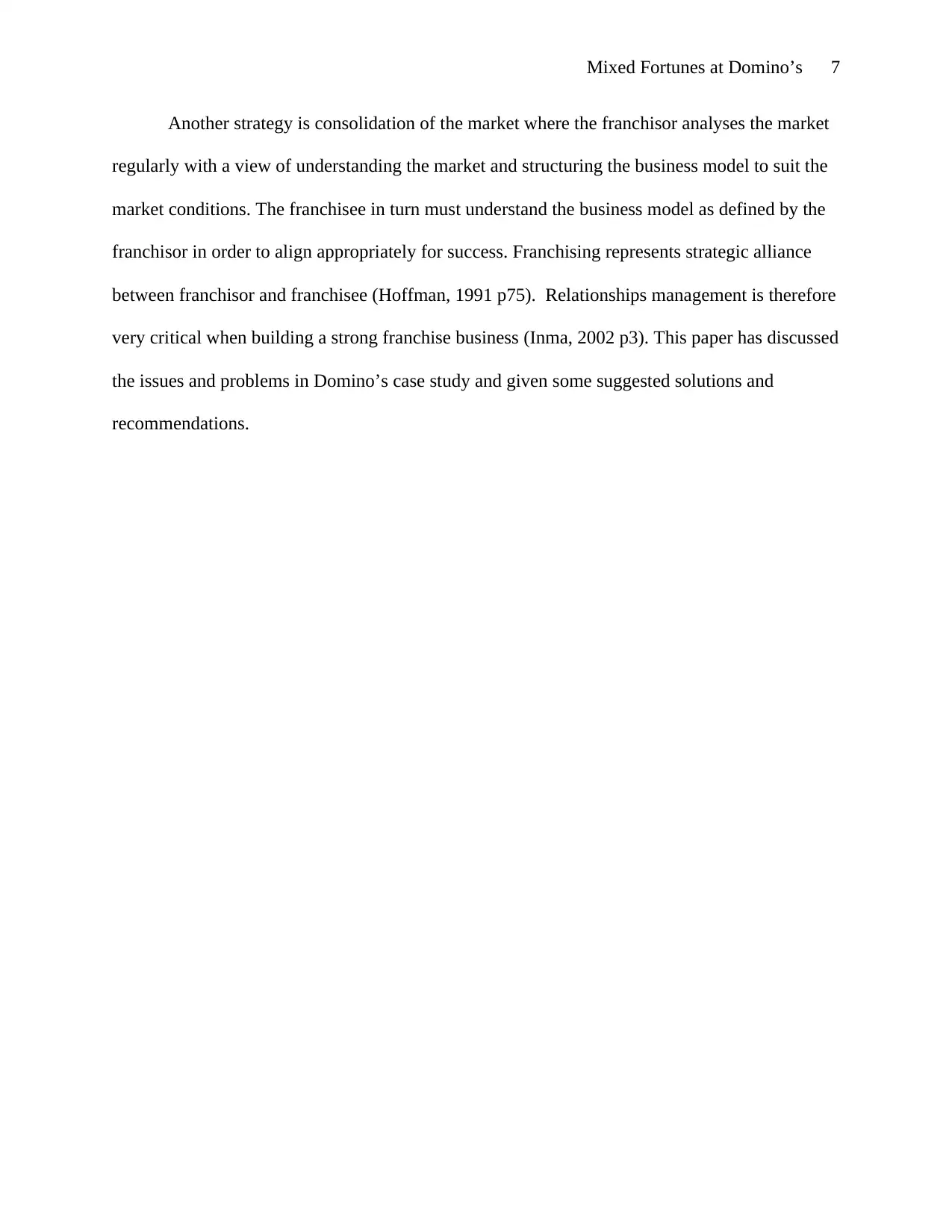
Mixed Fortunes at Domino’s 7
Another strategy is consolidation of the market where the franchisor analyses the market
regularly with a view of understanding the market and structuring the business model to suit the
market conditions. The franchisee in turn must understand the business model as defined by the
franchisor in order to align appropriately for success. Franchising represents strategic alliance
between franchisor and franchisee (Hoffman, 1991 p75). Relationships management is therefore
very critical when building a strong franchise business (Inma, 2002 p3). This paper has discussed
the issues and problems in Domino’s case study and given some suggested solutions and
recommendations.
Another strategy is consolidation of the market where the franchisor analyses the market
regularly with a view of understanding the market and structuring the business model to suit the
market conditions. The franchisee in turn must understand the business model as defined by the
franchisor in order to align appropriately for success. Franchising represents strategic alliance
between franchisor and franchisee (Hoffman, 1991 p75). Relationships management is therefore
very critical when building a strong franchise business (Inma, 2002 p3). This paper has discussed
the issues and problems in Domino’s case study and given some suggested solutions and
recommendations.
Paraphrase This Document
Need a fresh take? Get an instant paraphrase of this document with our AI Paraphraser
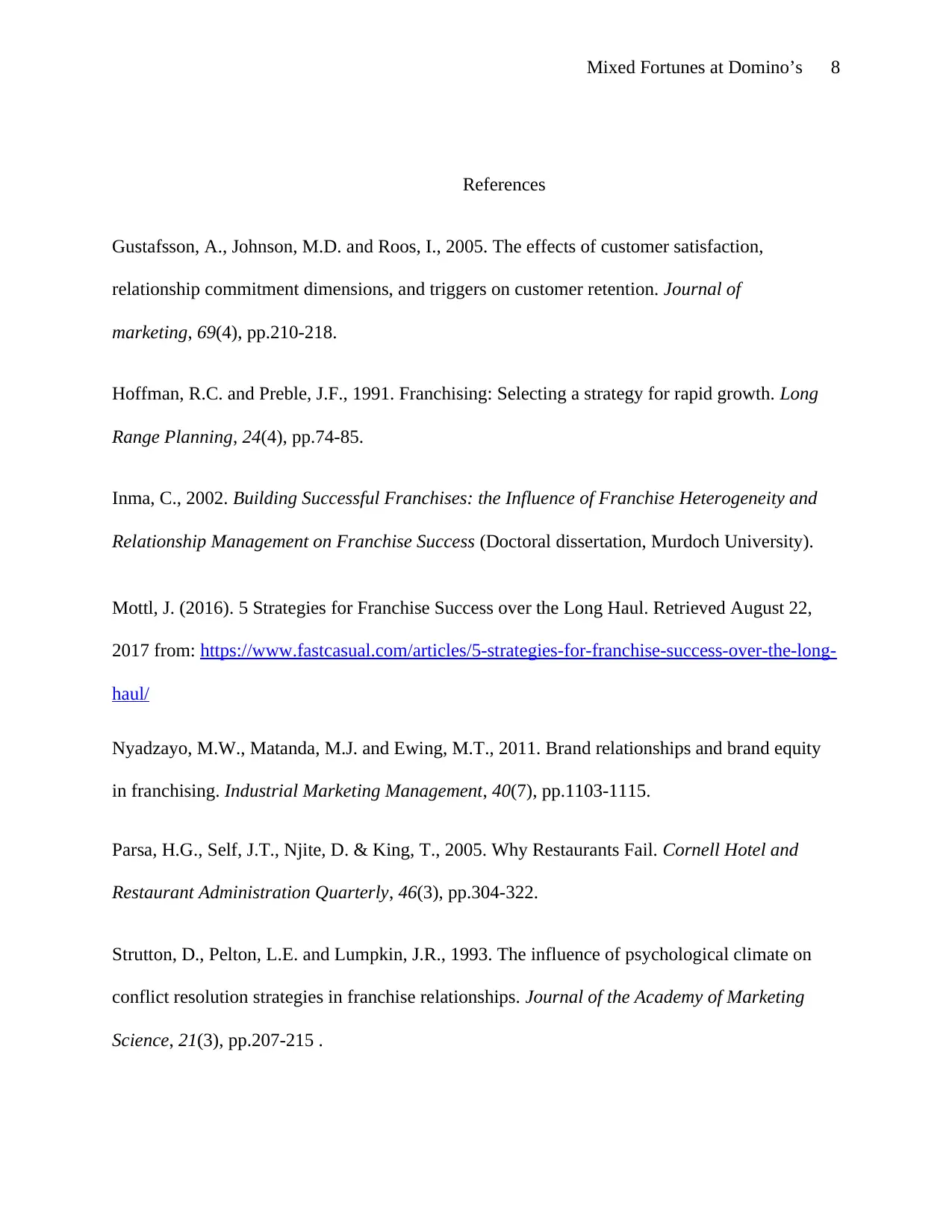
Mixed Fortunes at Domino’s 8
References
Gustafsson, A., Johnson, M.D. and Roos, I., 2005. The effects of customer satisfaction,
relationship commitment dimensions, and triggers on customer retention. Journal of
marketing, 69(4), pp.210-218.
Hoffman, R.C. and Preble, J.F., 1991. Franchising: Selecting a strategy for rapid growth. Long
Range Planning, 24(4), pp.74-85.
Inma, C., 2002. Building Successful Franchises: the Influence of Franchise Heterogeneity and
Relationship Management on Franchise Success (Doctoral dissertation, Murdoch University).
Mottl, J. (2016). 5 Strategies for Franchise Success over the Long Haul. Retrieved August 22,
2017 from: https://www.fastcasual.com/articles/5-strategies-for-franchise-success-over-the-long-
haul/
Nyadzayo, M.W., Matanda, M.J. and Ewing, M.T., 2011. Brand relationships and brand equity
in franchising. Industrial Marketing Management, 40(7), pp.1103-1115.
Parsa, H.G., Self, J.T., Njite, D. & King, T., 2005. Why Restaurants Fail. Cornell Hotel and
Restaurant Administration Quarterly, 46(3), pp.304-322.
Strutton, D., Pelton, L.E. and Lumpkin, J.R., 1993. The influence of psychological climate on
conflict resolution strategies in franchise relationships. Journal of the Academy of Marketing
Science, 21(3), pp.207-215 .
References
Gustafsson, A., Johnson, M.D. and Roos, I., 2005. The effects of customer satisfaction,
relationship commitment dimensions, and triggers on customer retention. Journal of
marketing, 69(4), pp.210-218.
Hoffman, R.C. and Preble, J.F., 1991. Franchising: Selecting a strategy for rapid growth. Long
Range Planning, 24(4), pp.74-85.
Inma, C., 2002. Building Successful Franchises: the Influence of Franchise Heterogeneity and
Relationship Management on Franchise Success (Doctoral dissertation, Murdoch University).
Mottl, J. (2016). 5 Strategies for Franchise Success over the Long Haul. Retrieved August 22,
2017 from: https://www.fastcasual.com/articles/5-strategies-for-franchise-success-over-the-long-
haul/
Nyadzayo, M.W., Matanda, M.J. and Ewing, M.T., 2011. Brand relationships and brand equity
in franchising. Industrial Marketing Management, 40(7), pp.1103-1115.
Parsa, H.G., Self, J.T., Njite, D. & King, T., 2005. Why Restaurants Fail. Cornell Hotel and
Restaurant Administration Quarterly, 46(3), pp.304-322.
Strutton, D., Pelton, L.E. and Lumpkin, J.R., 1993. The influence of psychological climate on
conflict resolution strategies in franchise relationships. Journal of the Academy of Marketing
Science, 21(3), pp.207-215 .
1 out of 8
Related Documents
Your All-in-One AI-Powered Toolkit for Academic Success.
+13062052269
info@desklib.com
Available 24*7 on WhatsApp / Email
![[object Object]](/_next/static/media/star-bottom.7253800d.svg)
Unlock your academic potential
Copyright © 2020–2025 A2Z Services. All Rights Reserved. Developed and managed by ZUCOL.





